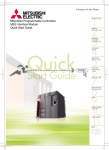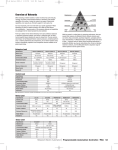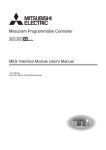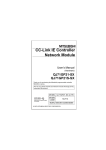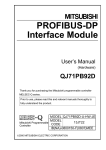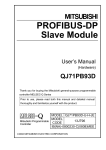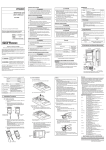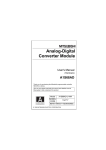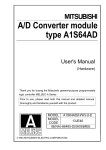Download MES Interface Module
Transcript
MES Interface Module User's Manual (Hardware) QJ71MES96 Thank you for purchasing the Mitsubishi programmable controller MELSEC-Q Series. Prior to use, please read both this manual and detailed manual thoroughly to fully understand the product. Model QJ71MES96-U-HW MODEL 13JY02 CODE IB(NA)-0800354-C(0809)MEE © 2006 MITSUBISHI ELECTRIC CORPORATION SAFETY PRECAUTIONS (Always read these precautions before using this equipment.) Before using this product, please read this manual and the relevant manuals introduced in this manual carefully and pay full attention to safety to handle the product correctly. Note that these precautions apply only to this product. For the safety precautions of the programmable controller system, please read the User's Manual for the CPU module used. In this manual, the safety instructions are ranked as "DANGER" and "CAUTION". DANGER Indicates that incorrect handling may cause hazardous conditions, resulting in death or severe injury. CAUTION Indicates that incorrect handling may cause hazardous conditions, resulting in medium or slight personal injury or physical damage. Note that the CAUTION level may lead to a serious consequence according to the circumstances. Always follow the instructions of both levels because they are important to personal safety. Please save this manual to make it accessible when required and always forward it to the end user. A-1 [Design Precautions] DANGER When controlling a running programmable controller (e.g. data modification), create an interlock circuit on sequence programs so that the whole system functions safely all the time. Also, be sure to read the manual carefully and ensure safety before performing any other controls such as operating status change. Especially, when controlling a programmable controller from a remote location via network, problems on the programmable controller side may not be dealt with promptly due to failure of data communications. Create an interlock circuit on a sequence program. For the operation status of each station at a communication error, refer to the manual for that station. Incorrect output or malfunctions may cause an accident. Install a safety circuit external to the programmable controller that keeps the entire system safe even when there are problems with the external power supply or the programmable controller. Otherwise, trouble could result from erroneous output or erroneous operation. When the programmable controller system security needs to be protected against illegal access from an external device via a network, take measures at the user's discretion. Do not write any data to the "System area" in the buffer memory of the intelligent function module. As for signals output from the programmable controller CPU to the intelligent function module, never output (ON) a "Use prohibited" signal. Doing these operations may cause malfunctions of the programmable controller system. A-2 [Design Precautions] CAUTION Do not bunch the control wires or communication cables with the main circuit or power wires, or install them close to each other. They should be installed 100 mm (3.94 inch) or more from each other. Not doing so could result in noise that would cause erroneous operation. During registering each setting, do not power OFF the mounted module or reset the programmable controller CPU. Otherwise, data in the CompactFlash card will be undefined. Therefore, resetting and re-registering data are required. This may also cause a module failure or malfunctions. [Installation Precautions] CAUTION Use the programmable controller under the environment specified in the User's Manual. Using this programmable controller in an environment outside the range of the general specifications could result in electric shock, fire, erroneous operation, and damage to or deterioration of the product. While pressing the installation lever located at the bottom of module, insert the module fixing tab into the fixing hole in the base unit until it stops. Then, securely mount the module with the fixing hole as a supporting point. Incorrect loading of the module can cause a malfunction, failure or drop. When using the programmable controller in the environment of much vibration, tighten the module with a screw. A-3 [Installation Precautions] CAUTION Completely turn off the externally supplied power used in the system before mounting or removing the module. Not doing so could result in damage to the product. Tighten the screw in the specified torque range. Undertightening can cause a drop, short circuit or malfunction. Overtightening can cause a drop, short circuit or malfunction due to damage to the screw or module. Do not directly touch the module's conductive parts or electronic components. Touching the conductive parts could cause an operation failure or give damage to the module. When connecting a connector, properly press, crimp, or solder it using the tools specified by the manufacturer. Incomplete connection may cause short-circuit, fire, and malfunctions. Push the CompactFlash card into the CompactFlash card slot and install it securely. After installing the CompactFlash card, check that it is inserted securely. Failure to do so may cause malfunctions due to poor contact. [Wiring Precautions] CAUTION Always store the communication cables and power cables connected to the module in the duct or fix them in place with clamps. Not doing so may cause swing, move, or poor connection of the cable, or damage of a module and/or cable due to careless pull, resulting in malfunctions. Install connectors securely to modules. A-4 [Wiring Precautions] CAUTION Tighten the screw in the specified torque range. Undertightening can cause a drop, short circuit or malfunction. Overtightening can cause a drop, short circuit or malfunction due to damage to the screw or module. When disconnecting communication cables connected to the module, never pull on the cable section. When using a cable with a connector, disconnect it with holding the connector connected to the module. When the cable is pulled while connected to the module, this may cause malfunctions or module/cable damage. Be sure there are no foreign substances such as sawdust or wiring debris inside the module. Such debris could cause fires, damage, or erroneous operation. The module has an ingress prevention label on its top to prevent foreign matter, such as wire offcuts, from entering the module during wiring. Do not peel this label during wiring. Before starting system operation, be sure to peel this label because of heat dissipation. [Disposal Precautions] CAUTION When disposing of this product, treat it as industrial waste. When disposing of batteries, separate them from other wastes according to the local regulations. (For details of the battery directive in EU member states, refer to the MES Interface Module User's Manual.) [Transportation Precautions] CAUTION When transporting lithium batteries, make sure to treat them based on the transportation regulations. (Refer to Chapter8 for details of the relevant models.) A-5 Revisions * The manual number is given on the bottom right of the front cover. Print date Jul., 2006 Dec., 2007 * Manual number IB(NA)-0800354-A IB(NA)-0800354-B Revision First edition Change of a term "PLC" was changed to "programmable controller". Correction SAFETY PRECAUTIONS, Chapter1, Section3.1 Sep., 2008 IB(NA)-0800354-C Correction About Manual, Compliance with the EMC and Low Voltage Directives, Section3.1 This manual confers no industrial property rights or any rights of any other kind, nor does it confer any patent licenses. Also, Mitsubishi Electric Corporation cannot be held responsible for any problems involving industrial property rights which may occur as a result of using the contents in this manual. © 2006 MITSUBISHI ELECTRIC CORPORATION A-6 CONTENTS 1. OVERVIEW .................................................................................................... 1 2. PERFORAMNCE SPECIFICATIONS ............................................................. 2 3. LOADING AND INSTALLATION .................................................................... 3 3.1 Handling Precautions ............................................................................... 3 3.2 Installation Environment ........................................................................... 3 4. PART NAMES ................................................................................................ 4 5. EXTERNAL WIRING ...................................................................................... 6 5.1 Connecting to the 10BASE-T/100BASE-TX ............................................. 6 6. SETTING FROM GX DEVELOPER ............................................................... 7 7. EXTERNAL DIMENSIONS ............................................................................. 9 8. TRANSPORTATION PRECAUTIONS.......................................................... 10 8.1 Controlled Model .................................................................................... 10 8.2 Handling for Shipping ............................................................................. 10 A-7 About Manual The following manual is also related to this product. In necessary, order it by quoting the details in the table below. Related Manual Manual No. (Model code) SH-080644ENG (13JR95) Manual name MES Interface Module User's Manual Compliance with the EMC and Low Voltage Directives (1) For programmable controller system To configure a system meeting the requirements of the EMC and Low Voltage Directives when incorporating the Mitsubishi programmable controller (EMC and Low Voltage Directives compliant) into other machinery or equipment, refer to Chapter 9 "EMC AND LOW VOLTAGE DIRECTIVES" of the QCPU User's Manual (Hardware Design, Maintenance and Inspection). The CE mark, indicating compliance with the EMC and Low Voltage Directives, is printed on the rating plate of the programmable controller. (2) For the product For the compliance of this product with the EMC and Low Voltage Directives, refer to Section 9.1.3 "Cables" in Chapter 9 "EMC AND LOW VOLTAGE DIRECTIVES" of the QCPU User's Manual (Hardware Design, Maintenance and Inspection). A-8 1. OVERVIEW This manual explains how to install the QJ71MES96 MES interface module (hereafter, abbreviated as MES interface module) and how to wire them with other devices. (Packing list) Model QJ71MES96 Product name QJ71MES96 MES interface module Battery (Q6BAT) 1 Quantity 1 1 2. PERFORAMNCE SPECIFICATIONS The following describes the performance specifications of the MES interface module. For general specifications of the MES interface module, refer to the following manual. QCPU User's Manual (Hardware Design, Maintenance and Inspection) Item Interface*1 Data transmission rate Transmission method Ethernet No. of cascaded stages Max. segment length*2 Supported function Supply power voltage Supply power CompactFlash capacity card Card size No. of installable cards Number of occupied I/O points Clock 5VDC internal current consumption External dimensions Weight *1 Specifications 100BASE-TX 10BASE-T 10 Mbps 100 Mbps Base band Maximum 4 stages Maximum 2 stages 100 m The auto-negotiation function is available. (automatically distinguishes 10BASE-T from 100BASE-TX) 3.3V 5% Maximum 150 mA TYPE I card 1 32 points/slot (I/O assignment: Intelli. 32 points) The clock data is obtained from a programmable controller CPU (in multiple CPU system, CPU No.1) or the SNTP server computer. 0.65A 98 (3.86) (H) 0.16kg 27.4 (1.08) (W) 90(3.54) (D) [mm (inch)] The MES interface module distinguishes 10BASE-T from 100BASE-TX depending on the device on other end. For connection with a hub not having the auto-negotiation function, set the hub side to half-duplex auto communication mode. *2 Distance between a hub and node. 2 3. LOADING AND INSTALLATION 3.1 Handling Precautions (1) Do not drop or apply severe shock to the module case since it is made of resin. (2) Before touching the module, always touch grounded metal, etc. to discharge static electricity from human body, etc. Not doing so can cause the module to fail or malfunction. (3) Tighten the module fixing screws within the following range. Screw Module fixing screw (usually not required) (M3 screw)*1 *1 Tightening torque range 0.36 to 0.48 N•m The module can be easily fixed onto the base unit using the hook at the top of the module. However, it is recommended to secure the module with the module fixing screw if the module is subject to significant vibration. 3.2 Installation Environment For details, refer to the user's manual for the CPU module used. 3 4. PART NAMES (1) With the LED cover closed QJ71MES96 RUN ERR. 1) PULL CF CARD 10BASE-T/ 100BASE-TX 1) 2) 100 M SD/ RD QJ71MES96 (2) With the LED cover open 3) PULL CF CARD 4) 5) 10BASE-T/ 100BASE-TX 100 M SD/ RD QJ71MES96 6) 7) 4 Name Indicator LED 1) 2) 10BASE-T/100BASE-TX interface connector (RJ45) 3) EJECT button 6) CompactFlash card slot CompactFlash card slot cover Battery 7) Battery connector pin 4) 5) Description Refer to (3) Indicator LED display contents. Used for connecting the MES interface module in 10BASE-T/100BASE-TX connection. (The MES interface module distinguishes 10BASE-T from 100BASE-TX depending on the device on other end.) Used for ejecting a CompactFlash card from the MES interface module. Used for installing a CompactFlash card to the MES interface module. Cover for the CompactFlash card slot Battery for file protection Connector pin for battery lead (The battery lead is disconnected from the connector at shipment to prevent battery consumption.) (3) Indicator LED display contents 10BASE-T/ 100BASE-TX QJ71MES96 100 M RUN ERR. SD/ RD Name RUN ERR. 100 M SD/RD LED status ON OFF OFF ON Flash ON OFF ON OFF Description In normal operation (It may take some time until the RUN LED is turned ON after the module is started.) Watchdog timer error (Hardware error) In normal status Module continuation error Module stop error 100 Mbps 10 Mbps During data send or data receive Data not transmitted 5 5. EXTERNAL WIRING 5.1 Connecting to the 10BASE-T/100BASE-TX When connecting to the 10BASE-T/100BASE-TX interface, use twisted pair cable. Use twisted pair cable that meets IEEE802.3 10BASE-T/100BASE-TX standards. (1) For 100 Mbps Either (a) or (b) of the following can be used. (a) Unshielded twisted pair cable (UTP cable), Category 5 (b) Shielded twisted pair cable (STP cable), Category 5 (2) For 10 Mbps Either (a) or (b) of the following can be used. (a) Unshielded twisted pair cable (UTP cable), Category 3 (4, 5) (b) Shielded twisted pair cable (STP cable), Category 3 (4, 5) POINT During high speed communication (100 Mbps) via 100BASE-TX connection, communication errors may occur due to the effect of high frequency noise generated from the equipment other than programmable controller, depending on the installation environment. Take the following countermeasures on the MES interface module side to eliminate the effect of high frequency noise when constructing the network system. (1) Wiring • Do not install the twisted pair cables together with the main circuit or power lines, or bring them close to each other. • Make sure to place the twisted pair cable in a duct. (2) Cable • In the environment where the cable is susceptible to noise, use the shielded twisted pair cable (STP cable). (3) 10 Mbps communication • Connect the 10 Mbps-compatible equipment with the MES interface module and transmit the data to the equipment at a transmission speed of 10 Mbps. 6 6. SETTING FROM GX DEVELOPER The intelligent function module switches are used to make the mode setting, default operation setting, battery error detection setting, and response monitoring time setting. Switch number Switch 1 Description Mode setting Default operation setting/battery error detection setting Response monitoring time setting For system use (Do not set.) Switch 2 Switch 3 (Lower byte) Switch 4 to 5 (1) Mode setting (Switch 1) Select the MES interface module operation mode. Setting number 0000h Online 0001h Hardware test 0002h Self-loopback test Item Description Normal operation mode Tests the ROM/RAM/intelligent function module switch settings. Executes the 10BASE-T/100BASE-TX interface self-diagnostics test. (2) Default operation setting/battery error detection setting (Switch 2) Select the default operation setting/battery error detection setting for the MES interface module. b15 to Specify "0".* b3 b2 b1 b0 Switch 2 Default operation setting [Account setting] Battery error detection setting 0: Detects battery errors. 1: Does not detect battery errors. 0: Operates according to [Account setting]. 1: Operates according to the default. User name :QJ71MES96 Password :MITSUBISHI Default operation setting [Network settings] 0: Operates according to [Network settings]. 1: Operates according to the default. IP ADDRESS :192.168.3.3 Subnet mask :255.255.255.0 * When other than 0 is specified in this area, "Switch setting error" (0180h) occurs at hardware test. 7 (a) Default operation setting (bit 0, 1) Set whether to operate [Account setting] and [Network settings] with their default. 1) [Account setting] (bit 0) 0: Operates according to [Account setting]. 1: Operates according to the default. 2) [Network settings] (bit 1) 0: Operates accroding to [Network settings]. 1: Operates according to the default. (b) Battery error detection setting (bit 2) Set whether to detect battery errors while the MES interface module is operating without battery. 0: Detects battery errors. 1: Does not detect battery errors. (3) Response monitoring time setting (Switch 3 (Lower byte)) Set the timeout time (Second) from when the MES interface module sends a request to the access target CPU until receiving the reply. A response time-out error (0002h) occurs if the access target CPU does not respond within the set time. Setting range: 15 to 255 (Second) (Default value: 15 seconds) When setting the time between 0 and 14 or making no settings, response monitoring time operates with 15 seconds. b15 to (Upper byte)* b8 b7 to (Lower byte) b0 Specify "0". * The upper byte data is ignored. However, when other than 0 is specified in this area, "Switch setting error" (0180h) occurs at hardware test. 8 Switch 3 Response monitoring time setting 15 to 255 (Second) When setting the time between 0 and 14 or making no settings, response monitoring time operates with 15 seconds. 7. EXTERNAL DIMENSIONS QJ71MES96 RUN ERR. PULL CF CARD 98 (3.86) 10BASE-T/ 100BASE-TX 100 M SD/ RD R1 (*1) QJ71MES96 27.4 (1.08) 14 (0.55) 90 (3.54) PULL CF CARD 10BASE-T/ 100BASE-TX 100 M SD/ RD QJ71MES96 (Unit: mm (inch)) *1 The bending radius near the connector (R1: yardstick) should be at least four times longer than the cable's outside diameter when the twisted pair cable is connected. 9 8. TRANSPORTATION PRECAUTIONS When transporting a battery containing lithium, handling according to transportation regulations is required. 8.1 Controlled Model The lithium battery used in the MES interface module is classified as follows. Product name Q series battery Model Product supply status Q6BAT Lithium battery Classification for transportation Non-hazardous material 8.2 Handling for Shipping The products are packed in accordance with transportation regulations before shipment. When transporting products after repacking or unpacking them, make them comply with the IATA Dangerous Goods Regulations, IMDG Code, and national transportation regulations. For details, consult with the shipping carrier. CompactFlash is a trademark of SanDisk Corporation. All other company names and product names used in this manual are trademarks or registered trademarks of their respective companies. 10 Warranty Mitsubishi will not be held liable for damage caused by factors found not to be the cause of Mitsubishi; machine damage or lost profits caused by faults in the Mitsubishi products; damage, secondary damage, accident compensation caused by special factors unpredictable by Mitsubishi; damages to products other than Mitsubishi products; and to other duties. For safe use • This product has been manufactured as a general-purpose part for general industries, and has not been designed or manufactured to be incorporated in a device or system used in purposes related to human life. • Before using the product for special purposes such as nuclear power, electric power, aerospace, medicine or passenger movement vehicles, consult with Mitsubishi. • This product has been manufactured under strict quality control. However, when installing the product where major accidents or losses could occur if the product fails, install appropriate backup or failsafe functions in the system. Country/Region Sales office/Tel U.S.A Mitsubishi Electric Automation Inc. 500 Corporate Woods Parkway Vernon Hills, IL 60061, U.S.A. Tel : +1-847-478-2100 Brazil MELCO-TEC Rep. Com.e Assessoria Tecnica Ltda. Rua Correia Dias, 184, Edificio Paraiso Trade Center-8 andar Paraiso, Sao Paulo, SP Brazil Tel : +55-11-5908-8331 Germany Mitsubishi Electric Europe B.V. German Branch Gothaer Strasse 8 D-40880 Ratingen, GERMANY Tel : +49-2102-486-0 U.K Mitsubishi Electric Europe B.V. UK Branch Travellers Lane, Hatfield, Hertfordshire., AL10 8XB, U.K. Tel : +44-1707-276100 Italy Mitsubishi Electric Europe B.V. Italian Branch Centro Dir. Colleoni, Pal. Perseo-Ingr.2 Via Paracelso 12, I-20041 Agrate Brianza., Milano, Italy Tel : +39-039-60531 Spain Mitsubishi Electric Europe B.V. Spanish Branch Carretera de Rubi 76-80, E-08190 Sant Cugat del Valles, Barcelona, Spain Tel : +34-93-565-3131 France Mitsubishi Electric Europe B.V. French Branch 25, Boulevard des Bouvets, F-92741 Nanterre Cedex, France TEL: +33-1-5568-5568 South Africa Circuit Breaker Industries Ltd. Private Bag 2016, ZA-1600 Isando, South Africa Tel : +27-11-928-2000 Country/Region Sales office/Tel Hong Kong Mitsubishi Electric Automation (Hong Kong) Ltd. 10th Floor, Manulife Tower, 169 Electric Road, North Point, Hong Kong Tel : +852-2887-8870 China Mitsubishi Electric Automation (Shanghai) Ltd. 4/F Zhi Fu Plazz, No.80 Xin Chang Road, Shanghai 200003, China Tel : +86-21-6120-0808 Taiwan Setsuyo Enterprise Co., Ltd. 6F No.105 Wu-Kung 3rd.Rd, Wu-Ku Hsiang, Taipei Hsine, Taiwan Tel : +886-2-2299-2499 Korea Mitsubishi Electric Automation Korea Co., Ltd. 1480-6, Gayang-dong, Gangseo-ku Seoul 157-200, Korea Tel : +82-2-3660-9552 Singapore Mitsubishi Electric Asia Pte, Ltd. 307 Alexandra Road #05-01/02, Mitsubishi Electric Building, Singapore 159943 Tel : +65-6470-2460 Thailand Mitsubishi Electric Automation (Thailand) Co., Ltd. Bang-Chan Industrial Estate No.111 Moo 4, Serithai Rd, T.Kannayao, A.Kannayao, Bangkok 10230 Thailand Tel : +66-2-517-1326 Indonesia P.T. Autoteknindo Sumber Makmur Muara Karang Selatan, Block A/Utara No.1 Kav. No.11 Kawasan Industri Pergudangan Jakarta - Utara 14440, P.O.Box 5045 Jakarta, 11050 Indonesia Tel : +62-21-6630833 India Messung Systems Pvt, Ltd. Electronic Sadan NO:III Unit No15, M.I.D.C Bhosari, Pune-411026, India Tel : +91-20-2712-3130 Australia Mitsubishi Electric Australia Pty. Ltd. 348 Victoria Road, Rydalmere, N.S.W 2116, Australia Tel : +61-2-9684-7777 HEAD OFFICE : TOKYO BUILDING, 2-7-3 MARUNOUCHI, CHIYODA-KU, TOKYO 100-8310, JAPAN NAGOYA WORKS : 1-14, YADA-MINAMI 5-CHOME, HIGASHI-KU, NAGOYA, JAPAN When exported from Japan, this manual does not require application to the Ministry of Economy, Trade and Industry for service transaction permission. Specifications subject to change without notice. Printed in Japan on recycled paper.




















